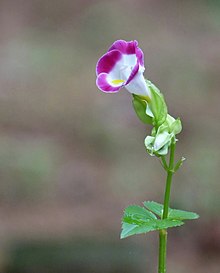

| Superasterids
| |
|---|---|

| |
| Torenia fournieri | |
| Scientific classification | |
| Kingdom: | Plantae |
| Clade: | Tracheophytes |
| Clade: | Angiosperms |
| Clade: | Eudicots |
| Clade: | Core eudicots |
| Clade: | Superasterids |
| Clades[1] | |
The superasterids are members of a large clade (monophyletic group) of flowering plants, containing more than 122,000 species.[citation needed]
The clade is divided into 20 orders as defined in APG IV system. These orders, in turn, together comprise about 146 families.[1]
The name is based upon the name "Asteridae", which had usually been understood to be a subclass.
The asterids, Berberidopsidales, Santalales, and Caryophyllales form the superasterids clade.[2] This is one of three groups that compose the Pentapetalae (core eudicots minus Gunnerales),[3] the others being Dilleniales and the superrosids (Saxifragales and rosids).[2]
The phylogeny of superasterids shown below is adapted from the Angiosperm Phylogeny Group website.[2]
| superasterids | |
|
Orders of flowering plants (APG IV)
| ||||||||||||||||||||||||||||||||||||||||||||||||||
|---|---|---|---|---|---|---|---|---|---|---|---|---|---|---|---|---|---|---|---|---|---|---|---|---|---|---|---|---|---|---|---|---|---|---|---|---|---|---|---|---|---|---|---|---|---|---|---|---|---|---|
| ||||||||||||||||||||||||||||||||||||||||||||||||||
| ||||||||||||||||||||||||||||||||||||||||||||||||||
| ||||||||||||||||||||||||||||||||||||||||||||||||||
| Superasteridae |
|
|---|---|